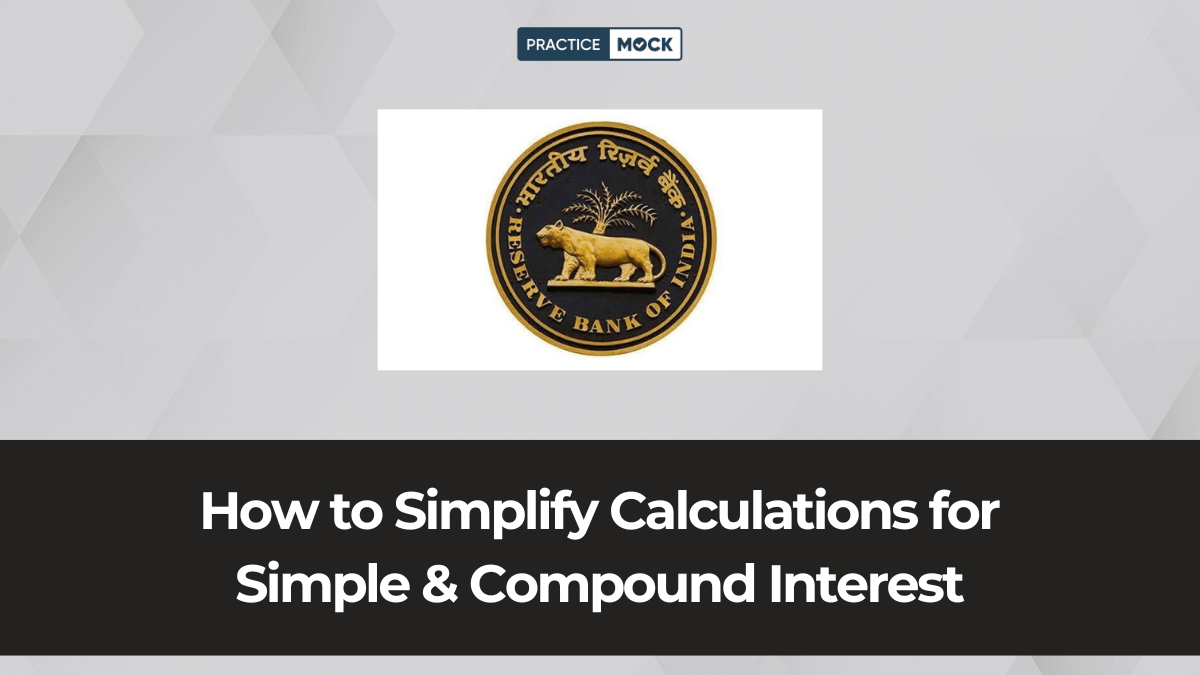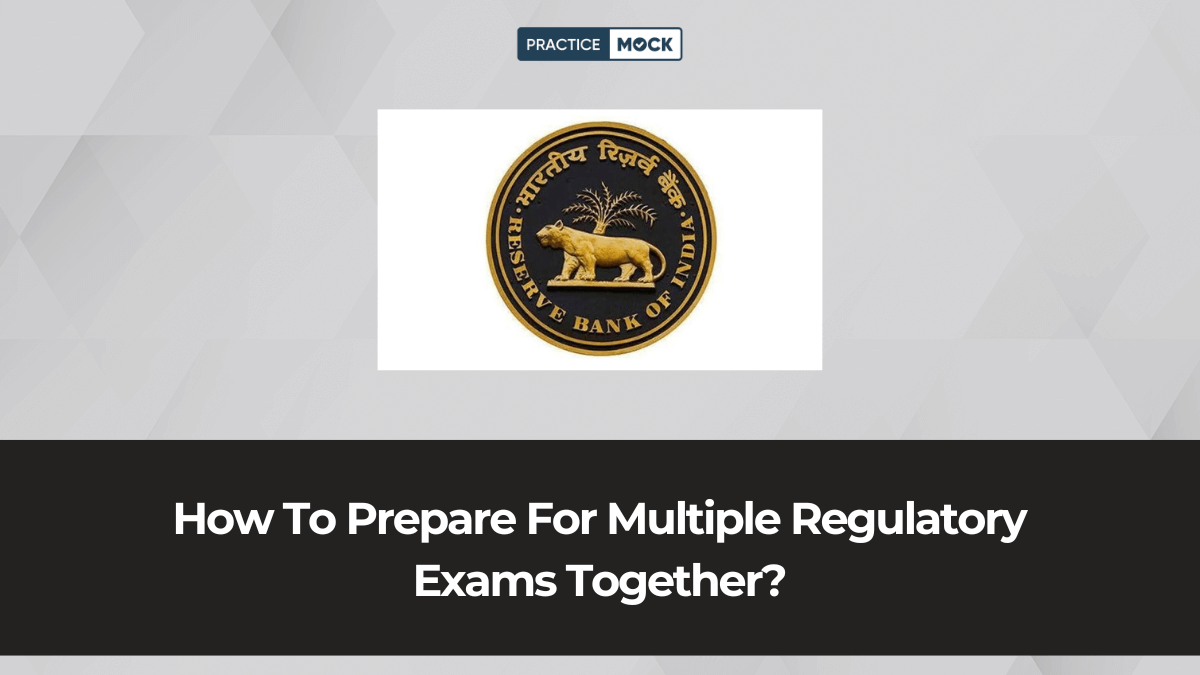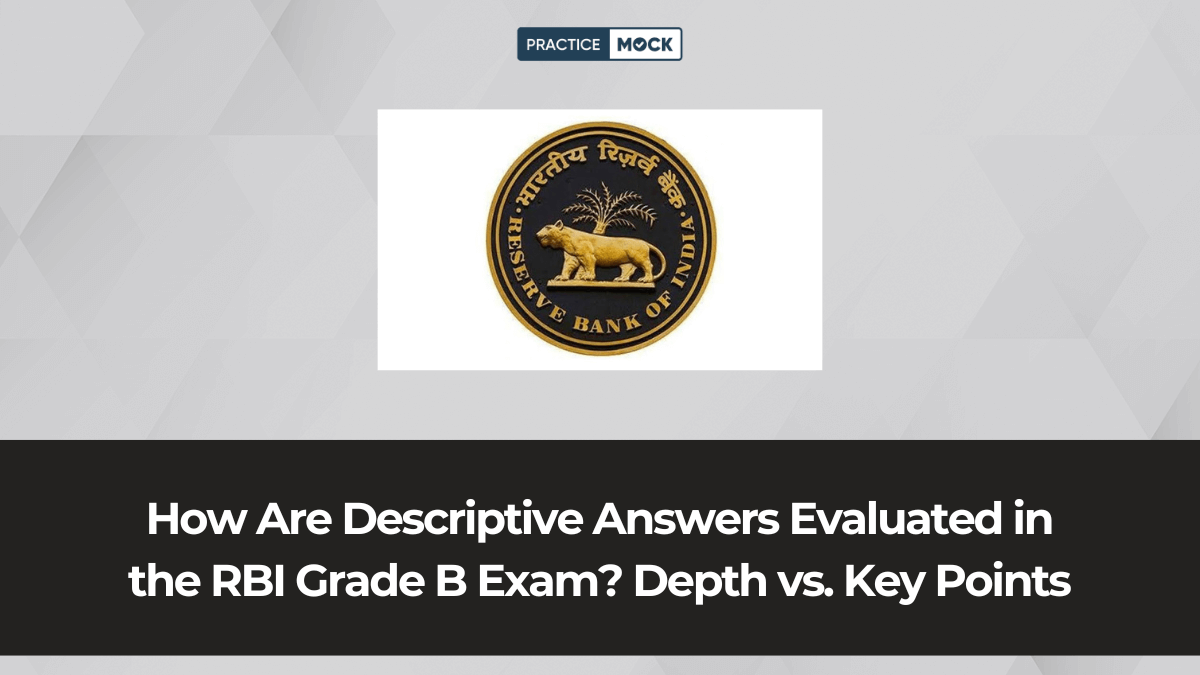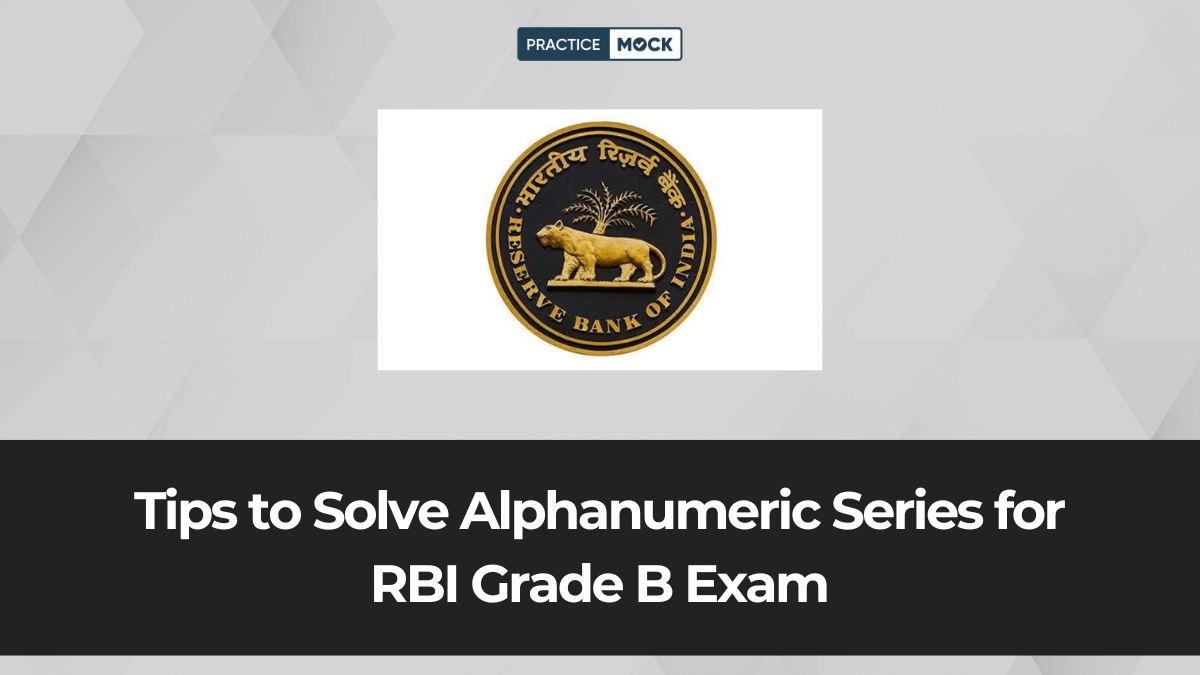How to Simplify Calculations for Simple & Compound Interest


Simple & Compound Interest is an essential topic in the Quantitative Aptitude section of the RBI Grade B Phase 1 exam. Questions from this topic frequently appear in the exam and carry a good weightage. Candidates can expect at least 2-4 questions from this area. This topic checks your understanding of time, rate, and financial calculation logic. With proper preparation, you can solve these questions quickly and accurately. In this blog, we will look at smart ways to simplify these interest-based problems. Later, you can also check out some sample questions to test your understanding.
Best Tips to Simplify Interest Calculations
For many aspirants, solving Simple and Compound Interest questions feels lengthy and confusing. But, with the right tricks, you can save time and solve them faster.
1. Learn Basic Formulas First
Understanding formulas is the base of solving these questions. Without this, shortcuts won’t help.
- Simple Interest = (P × R × T)/100
- Compound Interest = A – P
- A = P(1 + R/100)^T
- Know P = Principal, R = Rate, T = Time
- Learn when to use which formula
2. Convert Percentages Smartly
Interest questions involve lots of percentages. So, get comfortable converting them.
- 10% = 10/100 = 1/10
- 5% = 1/20, 12.5% = 1/8
- Use fraction form to speed up
- Know recurring percentages used in exams
- Practice converting decimals to fractions
3. Break Time Periods
When interest is calculated half-yearly or quarterly, split time properly.
- 1 year = 2 half-years
- 1 year = 4 quarters
- Adjust rate per period
- Use updated time and rate in formulas
- Avoid confusion with total time
4. Use Short Tricks for CI
For small values and short time, tricks work better than formulas.
- CI for 2 years = SI + (SI × R)/100
- Use percentage method for faster CI
- Try difference between CI and SI
- Break compound rate into parts
- Try ratio-based questions
5. Practice Mental Calculation
To save time in exams, reduce pen-paper use.
- Multiply in steps mentally
- Round off for quicker estimates
- Skip long divisions
- Practice tables and squares
- Keep paper clean for rough work
Important Sample Questions on Simple & Compound Interest
Question 1: Anand invested a certain amount of sum for five years in a scheme offering a compound interest of 20% p.a. compounded annually for first 2 years and simple interest of 15% p.a. on the accumulated sum for rest of the time. If the simple interest received by him is Rs. 2268, then find the sum invested by Anand.
A) Rs. 4000
B) Rs. 2500
C) Rs. 4500
D) Rs. 3500
E) Rs. 5000
Question 2: Tina and Meena invested Rs. P for 15 years and 13 years, respectively at 35% p.a. compound interest, compounded annually. If the total amount received by them is Rs. 5645, then find the share of Tina.
A) Rs. 3825
B) Rs. 3215
C) Rs. 3645
D) Rs. 3415
E) None of these
Question 3: A sum amounts to Rs. 4200 in 6 years and to Rs. 6300 in 12 years, when invested at compound interest, compounded annually. Find the sum.
A) Rs. 1600
B) Rs. 2800
C) Rs. 3200
D) Rs. 2400
E) Rs. 2000
Question 4: ‘A’, ‘B’ and ‘C’, each of them invested Rs. 3600 at the rate of 15% p.a., 25% p.a. and 40% p.a., respectively for 4 years, 6 years and 5 years, respectively. Find the sum of simple interests received by them.
A) Rs. 15480
B) Rs. 14040
C) Rs. 16200
D) Rs. 14760
E) Rs. 15320
Question 5: Ajit had Rs. 9600 with him. He invested some amount in scheme ‘P’ offering a simple interest of 22.5% p.a. and rest in scheme ‘B’ offering a compound interest of 20% p.a. compounded annually. If total interest earned from both schemes together at the end of 2 years is Rs. 4264, then find the interest received by Ajit from scheme ‘P’.
A) Rs. 1800
B) Rs. 3600
C) Rs. 2400
D) Rs. 3000
E) None of these
Question 6: Lakha has Rs. 24000 with him. He invested some amount at 15% p.a. simple interest for 8 years and the rest amount at 50% p.a. compound interest, compounded annually for 2 years. If the total interest received by him from the two investments together is Rs. 29100, then find the sum invested by him at simple interest.
A) Rs. 7200
B) Rs. 18000
C) Rs. 12000
D) Rs. 9600
E) Rs. 15000
Question 7: Rs. x when invested at r% p.a. simple interest for 12 years amounts to 10 times of itself. If Rs. (x + 180) when invested at (r – 43)% p.a. simple interest for 5 years amounts to Rs. 6240, then find the value of ‘x’.
A) 2220
B) 1920
C) 2520
D) 3020
E) None of these
Question 8: Rs. (x + 550) when invested at 16% p.a. for 5 years, gives simple interest of Rs. (0.6x + 1050). Find the amount received when Rs. (x – 650) is invested at 15% p.a. simple interest for 8 years.
A) Rs. 5080
B) Rs. 5420
C) Rs. 4860
D) Rs. 5280
E) Cannot be determined
Question 9: Ram borrows Rs. ‘x’ from Shyam at a rate of 20% p.a. compound interest, compounded annually for 2 years. He lends that amount to Ghanshyam at a rate of 30% p.a. simple interest for 2 years. If profit made by Ram in the whole transaction is Rs. 8000, then find the value of ‘x’.
A) Rs. 60000
B) Rs. 50000
C) Rs. 64000
D) Rs. 52000
E) None of these
Question 10: Ashwin invested Rs. x at 50% p.a. compound interest, compounded annually for 2 years. If the amount received by him is Rs. 3690, then find the value of (3200 – x).
A) 1560
B) 2080
C) 1320
D) 1960
E) None of these
प्रश्न 1: Anand कुछ राशि को पांच वर्ष के लिए एक scheme में निवेश करता है जो पहले दो वर्ष के लिये 20% प्रतिवर्ष वार्षिक देय चक्रवृद्धि ब्याज और शेष समय के लिए संचित राशि पर 15% प्रतिवर्ष साधारण ब्याज प्रदान करता है।यदि उसके द्वारा प्राप्त साधारण ब्याज Rs. 2268 है, तो Anand द्वारा निवेश की गयी राशि ज्ञात कीजिए।
A) Rs. 4000
B) Rs. 2500
C) Rs. 4500
D) Rs. 3500
E) Rs. 5000
प्रश्न 2: Tina और Meena ने क्रमशः15 वर्ष और 13 वर्ष के लिए Rs. P को क्रमशः 35% वार्षिक देय चक्रवृद्धि ब्याज पर निवेश किया। यदि उनके द्वारा प्राप्त कुल राशि Rs. 5645 है, तो Tina का हिस्सा ज्ञात कीजिए।
A) Rs. 3825
B) Rs. 3215
C) Rs. 3645
D) Rs. 3415
E) इनमें से कोई नहीं
प्रश्न 3: एक राशि को जब वार्षिक देय चक्रवृद्धि ब्याज पर निवेश किया जाता है तो वह छह वर्ष में सयंचित होकर Rs. 4200 और 12 वर्षों में सयंचित होकर Rs. 6300 हो जाती है|राशि ज्ञात कीजिए।
A) Rs. 1600
B) Rs. 2800
C) Rs. 3200
D) Rs. 2400
E) Rs. 2000
प्रश्न 4: ‘A’, ‘B’ और ‘C’ में से प्रत्येक ने Rs. 3600 को क्रमशः 15% प्रति वर्ष, 25% प्रति वर्ष और 40% प्रतिवर्ष की दर से क्रमशः 4 वर्ष, 6 वर्ष और 5 वर्ष निवेश किया|उनके द्वारा अर्जित साधारण ब्याज का योग ज्ञात कीजिए।
A) Rs. 15480
B) Rs. 14040
C) Rs. 16200
D) Rs. 14760
E) Rs. 15320
प्रश्न 5: Ajit के पास Rs. 9600 है। उसने scheme ‘P’ में कुछ राशि का निवेश किया है जिसमें 22.5% प्रति वर्ष साधारण ब्याज की दर से पेशकश की गई है और शेष को scheme ‘B’ में निवेश किया है जो 20% प्रतिवर्ष वार्षिक देय चक्रवृद्धि ब्याज प्रदान करता है। यदि 2 वर्ष के अंत में दोनों schemes से अर्जित कुल ब्याज Rs. 4264 है, तो Ajit को scheme ‘P’ से अर्जित ब्याज ज्ञात कीजिए।
A) Rs. 1800
B) Rs. 3600
C) Rs. 2400
D) Rs. 3000
E) इनमें से कोई नहीं
प्रश्न 6: Lakha के पास Rs. 24000 है| उसने 8 वर्षों के लिए कुछ राशि को 15% प्रति वर्ष साधारण ब्याज की दर से और शेष राशि को 2 वर्ष के लिए 50% प्रतिवर्ष वार्षिक देय चक्रवृद्धि ब्याज पर निवेश किया।यदि उसे दोनों निवेशों से प्राप्त कुल ब्याज Rs. 29100 है, तो उसके द्वारा साधारण ब्याज पर निवेश की गयी राशि ज्ञात कीजिए?
A) Rs. 7200
B) Rs. 18000
C) Rs. 12000
D) Rs. 9600
E) Rs. 15000
प्रश्न 7: Rs. x को जब 12 वर्षों के लिए r% प्रति वर्ष साधारण ब्याज की दर से निवेश किया जाता है तो वह संचित होकर स्वयं का 10 गुना हो जाता है। यदि 5 वर्षों के लिए Rs. (x + 180) को (r – 43)% प्रति वर्ष साधारण ब्याज की दर से निवेश किया जाता है तो वह संचित होकर Rs. 6240 प्रदान करती है, तो ‘x’ का मान ज्ञात कीजिए।
A) 2220
B) 1920
C) 2520
D) 3020
E) इनमें से कोई नहीं
प्रश्न 8: Rs. (x + 550) को जब पांच वर्ष के लिए 16% प्रति वर्ष की दर से निवेश किया जाता है तो वह साधारण ब्याज के रूप में (0.6x + 1050) प्रदान करती है। प्राप्त राशि ज्ञात करें जब आठ वर्ष के लिए Rs. (x – 650) को 15% प्रति वर्ष साधारण ब्याज की दर से निवेश किया जाता है।
A) Rs. 5080
B) Rs. 5420
C) Rs. 4860
D) Rs. 5280
E) निर्धारित नहीं किया जा सकता
प्रश्न 9: Ram ने Shyam से दो वर्ष के लिए 20% वार्षिक देय चक्रवृद्धि ब्याज पर Rs. ‘x’ उधार लेता है। वह उस राशि को दो वर्ष के लिए 30% प्रति वर्ष साधारण ब्याज की दर से Ghanshyam को उधार देता है। यदि पूरे लेन-देन में Ram द्वारा अर्जित लाभ Rs. 8000 है, तो ‘x’ का मान ज्ञात कीजिए।
A) Rs. 60000
B) Rs. 50000
C) Rs. 64000
D) Rs. 52000
E) इनमें से कोई नहीं
प्रश्न 10: अश्विन ने दो वर्ष के लिए Rs. x को 50% प्रतिवर्ष वार्षिक देय चक्रवृद्धि ब्याज पर निवेश किया। यदि उसके द्वारा प्राप्त राशि Rs. 3690 है, तो (3200 – x) का मान ज्ञात कीजिए।
A) 1560
B) 2080
C) 1320
D) 1960
E) इनमें से कोई नहीं
ANSWER KEYS and SOLUTIONS:
| 1) – D) | 2) – C) | 3) – B) | 4) – D) | 5) – A) | 6) – B) |
| 7) – A) | 8) – D) | 9) – B) | 10) – A) |
Solution 1: D)
Let amount of sum invested is Rs. ‘P’.
According to question;
0.15 × 3 × (1.2)2 × P = 2268
Or, P = 3500
Hence, option d.
Solution 2: C)
Ratio of the amount received by Tina and Meena= {P(1 + 35/100)15}/{P(1 + 35/100)13} = (1 + 35/100)2
Or, the ratio of amount received by Tina and Meena = (135/100)2 = 729:400
Therefore, share of Tina = 5645 × (729/1129) = Rs. 3645
Hence, option c.
Solution 3: B)
Let the sum invested be Rs. P and the rate of interest be R% p.a.
According to the question,
P(1 + R/100)6 = 4200….(1)
And, P(1 + R/100)12 = 6300…. (2)
Dividing equation (2) by (1), we get
(1 + R/100)6 = 3/2
Therefore, P(1 + R/100)6 = 4200
Or, P = 4200 × (2/3) = Rs. 2800
Hence, option b.
Solution 4: D)
Simple interest received by ‘A’ = (3600 × 15 × 4)/100
Simple interest received by ‘B’ = (3600 × 25 × 6)/100
Simple interest received by ‘C’ = (3600 × 40 × 5)/100
Required sum = (3600/100) × {(15 × 4) + (25 × 6) + (40 × 5)} = Rs. 14760
Hence, option d.
Solution 5: A)
Amount invested by him in scheme ‘P’ is Rs. ‘x’
So, amount invested in scheme ‘Q’ = Rs. ‘9600 – x’
According to question;
0.225 × 2 × x + 0.44 × (9600 – x) = 4264
Or, 0.01x = 4264 – 4224
Or, 0.01x = 40
Or, x = 4000
Interest received from scheme ‘P’ = 0.225 × 2 × 4000 = Rs. 1800
Hence, option a.
Solution 6: B)
Let the sum invested at simple interest be Rs. x
Therefore, sum invested at compound interest = Rs. (24000 – x)
According to the question,
(x × 15 × 8)/100 + (24000 – x)(1 + 50/100)2 – (24000 – x) = 29100
1.2x + 1.25(24000 – x) = 29100
Or, 1.2x + 30000 – 1.25x = 29100
Or, 0.05x = 900
Or, x = 900/0.05 = 18000
Therefore, sum invested by him at simple interest = x = Rs. 18000
Hence, option b.
Solution 7: A)
According to the question,
(x × 12 × r)/100 = 10x – x
Or, 0.12xr = 9x
Or, r = 9/0.12 = 75
Therefore, (r – 43)% = 32%
Or, {(x + 180) × 32 × 5}/100 = 6240 – (x + 180)
Or, 1.6(x + 180) + (x + 180) = 6240
Or, 2.6(x + 180) = 6240
Or, x + 180 = 2400
Or, x = 2220
Hence, option a.
Solution 8: D)
According to the question,
{(x + 550) × 16 × 5}/100 = 0.6x + 1050
Or, 0.8(x + 550) = 0.6x + 1050
Or, 0.8x + 440 = 0.6x + 1050
Or, 0.2x = 610
Or, x = 3050
Therefore, sum invested at 15% p.a. simple interest = (x – 650) = 2400
Required amount received = {(2400 × 15 × 8)/100} + 2400 = 2880 + 2400 = Rs. 5280
Hence, option d.
Solution 9: B)
According to question;
0.30 × 2 × x – [(1 + 0.2)2 – 1] × x = 8000
Or, 3x/5 – 11x/25 = 8000
Or, (15x – 11x)/25 = 8000
Or, 4x = 8000 × 25
Or, x = 50000
Hence, option b.
Solution 10: A)
According to the question,
{x(1 + 50/100)2} = 3690
Or, 2.25x = 3690
Or, x = 1640
Required value = (3200 – x) = (3200 – 1640) = 1560
Hence, option a.
Takeaway
You can easily master Simple and Compound Interest with the right tricks. Focus on formulas, break down time and rate smartly, and practice mental math. These small habits will help you solve questions quicker and accurately in the RBI Grade B exam. PracticeMock can help you sharpen these skills with regular mock tests.
Join our unique Telegram group immediately to skyrocket your preparation for Regulatory exams via expert guidance, top tips, perfect feedback, and much more!
[ Click Here to join the PracticeMock Telegram Group! ]
[ Click Here to join the PracticeMock Telegram Discussion Group Link! ]
Also, go through the 60 days Study Plan for the RBI Grade B Exam 2025
Related Posts:
FAQs
Quantitative Phase 1 – Aptitude section.
Usually 2 to 4 questions.
Mostly formula-based with some tricky cases.
Yes, very important for quick solving.
Yes, they save a lot of time in exams.
Recent Posts
Inequality for NABARD Grade A
In this article we have discussed the importance of inequality for the NABARD Grade A…
SSC Notifications may be delayed?, Aadhaar-Based Biometric Authentication Implementation
The SSC has released a notification related to SSC Calendar 2025-26. Check all the information…
Direction And Distance Questions For SSC CGL, Download Free PDF
In this blog, we have provided the Direction and Distance Questions for SSC CGL Exam.…
Syllogism for NABARD Grade A
In this article we have discussed the importance of Syllogism for the NABARD Grade A…
Reasoning Important Question For IBPS RRB PO 2025, Get PDF For Prelims Exam
In this article, we are providing the Reasoning Important Question PDF for IBPS RRB PO…
SSC CGL General Awareness Mock Test Free, Based on PYQs, Get Free PDF
In this blog, we have provided the SSC CGL General Awareness Mock Test Based On…



